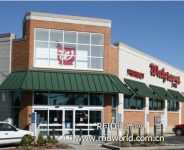
Walgreens completes the labeling of the promotional booths of 5000 chain pharmacies across the country
[ad_1]
Walgreens, the largest pharmacy chain in the United States, has implemented an RFID tracking system for the promotional display racks of all 5,000 pharmacies across the country (except for a few pharmacies). The cosmetics company Revlon claims that the system data has helped the company increase sales of Walgreen promotional products.
This system has undergone 8 years of piloting and testing at Walgreens, involving system developers Goliath Solutions, Revlo and other consumer product packaging (CPG) manufacturers, and officially began installation in 2007. In addition, Walgreens also plans to test an upgraded version of this system, using EPC Gen 2 UHF tags instead of the semi-active tags currently used.

Walgreens, the largest chain pharmacy company in the United States
In a statement, Walgreens’ purchasing director David Van Howe stated that the RFID system enables chain pharmacies and their CPG suppliers to manage promotional booths more effectively, thereby increasing sales of promotional products.
Revlon is one of Walgreen’s many CPG suppliers that label promotional items, said Gary Overhultz, Goliath’s chief information officer. Revlon’s labeling goal is to understand which products are successful, to ensure that Walgreens and Revlon make full use of relevant information to better carry out promotional activities.
Revlon is very keen to understand the value of different booths (based on the number of promotional items sold). The company found that the use of sales data and location information related to promotional booths can better ensure that the most popular products are in the right place in the store at the right time, thereby increasing sales to 200%-400% of the original, Overhultz said .
The system uses RFID hardware and software designed and supplied by Goliat. Each store only needs to install one RFID reader, which is connected to a row of antennas hidden in the ceiling. The battery-powered semi-passive RFID tags operate at 902-933 MHz and are installed on promotional booths by Walgreens or CPG vendors. Tags are usually asleep until the RFID reader instructs them to send data.
The tag sends the ID code through a proprietary air interface protocol, and uses its built-in battery to power part of the circuit system, thereby obtaining a longer reading distance than a passive tag. The reader sends the received data, including the location of the booth (based on the antenna receiving the signal), to a server via the Internet, where Goliath software compiles the data, and manufacturers and retailers can obtain this information online. In this way, Revlon and other Walgreens suppliers can learn about the booth information in real time.
The data from the cashier terminal is also sent to the server, and the software compares the information with the location of the booth to evaluate the effectiveness of the booth and its location.
Semi-passive tags have a long read range, about 100-200 feet, which makes them a good choice for stores. However, EPC Gen 2 UHF tags are cheaper and more attractive to retailers. Walgreens will start a new test in Chicago pharmacies at the end of this month. Overhultz said that if the test shows that the EPC Gen 2 UHF tags are working well, the readers of all pharmacies will be replaced uniformly.
[ad_2]






